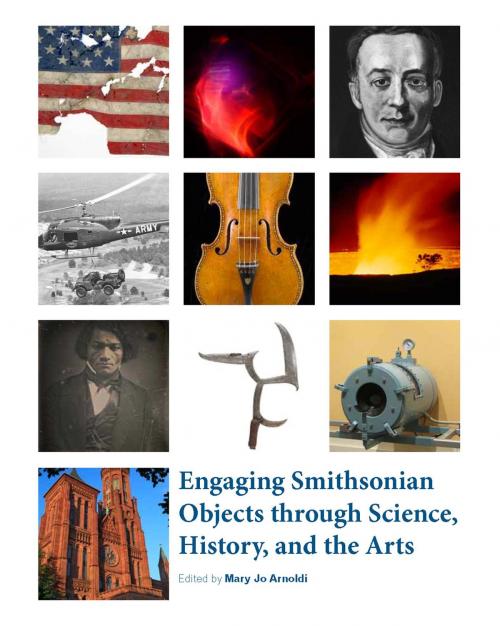Engaging Smithsonian Objects through Science, History, and the Arts
Nonfiction, Home & Garden, Antiques & Collectibles, Popular Culture, Social & Cultural Studies, Social Science, Anthropology, Art & Architecture, General Art| Author: | ISBN: | 9781935623731 | |
| Publisher: | Smithsonian | Publication: | January 5, 2016 |
| Imprint: | Smithsonian Institution Scholarly Press | Language: | English |
| Author: | |
| ISBN: | 9781935623731 |
| Publisher: | Smithsonian |
| Publication: | January 5, 2016 |
| Imprint: | Smithsonian Institution Scholarly Press |
| Language: | English |
How do we come to know the world around us? What about worlds apart from our own—outer space, distant cultures, or even long-past eras of history? Engaging Smithsonian Objects through Science, History, and the Arts explores these questions and suggests an answer: we come to know our world and worlds apart through the objects that represent them.
Objects are a window, and by looking through them we can learn and understand more about the people who made them and the time and place they came from. In the pursuit of this understanding museums are invaluable; they are repositories not just of things but also of past, present, and future knowledge.
Engaging Smithsonian Objects puts these ideas into practice, using objects to bring us to new knowledge and showing how museums support us in the endeavor. The book is organized around ten objects from the Smithsonian’s vast collections. Some of the objects are iconic—the Ruby Slippers from the The Wizard of Oz or three Stradivarius string instruments*—*while others are more ordinary, though no less interesting—an Iron Lung or a Hawaiian gourd drum. Two different authors with expertise in different academic disciplines write about each object from their unique professional and personal perspective. Both the authors and the ten featured objects represent a range of academic disciplines, from art to anthropology to geology. Taken together, the twenty essays in the book demonstrate just how much we can learn from objects by considering their kaleidoscopic meaning and significance from a variety of viewpoints.
The book’s interdisciplinary engagement with objects was inspired by the Smithsonian Material Culture Forum, now in its twenty-sixth year. For students of material culture and museum studies, this book illustrates the vitality and value of exploring material culture through the lens of intersecting disciplinary perspectives. For students of curiosity and lifelong learning, this book offers a lively and thoughtful look into the Smithsonian’s collection and the many vibrant worlds it represents. Richly illustrated with color plates and photographs throughout, Engaging Smithsonian Objects through Science, History, and the Arts is a beautiful and stimulating answer to the question, “How do we know our world, and how can we know more?”
How do we come to know the world around us? What about worlds apart from our own—outer space, distant cultures, or even long-past eras of history? Engaging Smithsonian Objects through Science, History, and the Arts explores these questions and suggests an answer: we come to know our world and worlds apart through the objects that represent them.
Objects are a window, and by looking through them we can learn and understand more about the people who made them and the time and place they came from. In the pursuit of this understanding museums are invaluable; they are repositories not just of things but also of past, present, and future knowledge.
Engaging Smithsonian Objects puts these ideas into practice, using objects to bring us to new knowledge and showing how museums support us in the endeavor. The book is organized around ten objects from the Smithsonian’s vast collections. Some of the objects are iconic—the Ruby Slippers from the The Wizard of Oz or three Stradivarius string instruments*—*while others are more ordinary, though no less interesting—an Iron Lung or a Hawaiian gourd drum. Two different authors with expertise in different academic disciplines write about each object from their unique professional and personal perspective. Both the authors and the ten featured objects represent a range of academic disciplines, from art to anthropology to geology. Taken together, the twenty essays in the book demonstrate just how much we can learn from objects by considering their kaleidoscopic meaning and significance from a variety of viewpoints.
The book’s interdisciplinary engagement with objects was inspired by the Smithsonian Material Culture Forum, now in its twenty-sixth year. For students of material culture and museum studies, this book illustrates the vitality and value of exploring material culture through the lens of intersecting disciplinary perspectives. For students of curiosity and lifelong learning, this book offers a lively and thoughtful look into the Smithsonian’s collection and the many vibrant worlds it represents. Richly illustrated with color plates and photographs throughout, Engaging Smithsonian Objects through Science, History, and the Arts is a beautiful and stimulating answer to the question, “How do we know our world, and how can we know more?”















